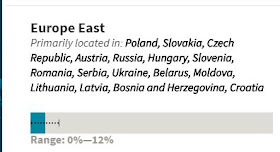One of my Great-Great Grandfather's was French Canadian. Living DNA gave me 5% French, which is about right. 23andMe combines French and German, and the other companies don't give me any French estimates, so I can't compare this estimate with any others.
My Great-Great Grandmother Mary E. Owens is thought to have some Welsh ancestry. The surname Owens is associated with Wales. Living DNA gives me one result for South Wales and one for South Border Wales. The other companies haven't separated out Wales from other results.
I'm skeptical of the 2% Pashtun result and the Mordovian? I don't know, but I haven't found anyone from those areas on my tree so far. None of the other companies have that estimate for me.
Living DNA points to Northern Ireland as the source of my Irish. I do have some Northern Irish roots. My Irish Great-Grandmother was from Galway Ireland, however. Living DNA didn't show the Irish Republic as a sub-region.
Living DNA was right in line with the other companies as far as my Native American estimate at 5%. They also estimated around 1.5% West African, which is right on tract with the other companies.
Below I compare my Living DNA results with other companies.
British Isles/ Ireland
My maternal grandfather Charles Forgey was substantially Scots-Irish. He would represent a quarter of my ancestry. On my father's side I have just a trace of British Isles ancestry. One of my great-grandmother's was Irish from Galway, which would amount to the highest British/Irish on my father's side . I would say my British Isles/ Irish should be no more than half of my ancestry, considering one of my grandmother's was Nicaraguan, and another grandfather was Eastern European from Austria. The 68% Living DNA wouldn't be correct.
Living DNA
 |
| Living DNA |
AncestryDNA
 |
| AncestryDNA 60% total for Irish Great Britain |
23andMe
 |
| 23andMe 44% |
MyHeritage
| MyHeritage |
FamilyTreeDNA
 |
| FamilyTreeDNA |
Eastern Europe
My grandfather Rudolph Kapple/Kappel was born in Austria. I've traced his family in Eastern Europe back around 300 years. The Living DNA estimate of 4.8% Eastern European would be too low. If they had also estimated some German ethnicity, in edition to that estimate, Living DNA's Eastern European would be more accurate.
Living DNA
AncestryDNA
23andMe
MyHeritage
FamilyTreeDNA
DNA.Land
Iberian/Southern European
My grandmother Graciela Del Castillo was born in the Central American country of Nicaragua. Her ancestors had Spanish surnames such as Del Castillo, Garcia, Granizo, Alvarado, and Lacayo etc. Since I received around a quarter of my DNA from her I would have expected around 15% to 20% Iberian admixture, considering there is Native American and African admixture which would need to be taken into account too.
Living DNA
AncestryDNA
23andMe
MyHeritage
Familytree DNA
No Iberian
DNA.Land
The Living DNA British Isles estimate is over estimated at 68%. It would definitely be under 50%, maybe around 40%. I know for certain my Nicaraguan grandmother didn't have British Isles ancestry, nor my Austrian grandfather. That would eliminate around 50% from British Isles consideration. Most companies are overestimating British Isles ancestry and underestimating less common admixtures. 23andMe is the best with the 44% British Isles/ Irish estimate.
All of the companies have difficulty detecting Iberian and Eastern European. Again 23andMe is best. Some of my Eastern European ancestors were German. Combining 23andMe's French and German estimates with Eastern European would represent my Austrian grandfather's heritage percentage wise. The Iberian estimate at 23andMe would be more in line with my Nicaraguan grandmother's heritage.
Hopefully with more people testing from more places the Living DNA ethnicity results will become more accurate.
I'm looking forward to getting matches with Living DNA once they begin introducing matching sometime this year. As I understand it they will have a chromosome browser, which will help me collect more segments for my segment map.
You can upload your raw data from other companies to Living DNA for free and receive matches once this service is introduced. Living DNA's "One Family One World" project sounds like a great project to contribute your raw data to.
All of the companies have difficulty detecting Iberian and Eastern European. Again 23andMe is best. Some of my Eastern European ancestors were German. Combining 23andMe's French and German estimates with Eastern European would represent my Austrian grandfather's heritage percentage wise. The Iberian estimate at 23andMe would be more in line with my Nicaraguan grandmother's heritage.
Hopefully with more people testing from more places the Living DNA ethnicity results will become more accurate.
I'm looking forward to getting matches with Living DNA once they begin introducing matching sometime this year. As I understand it they will have a chromosome browser, which will help me collect more segments for my segment map.
You can upload your raw data from other companies to Living DNA for free and receive matches once this service is introduced. Living DNA's "One Family One World" project sounds like a great project to contribute your raw data to.






















